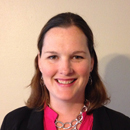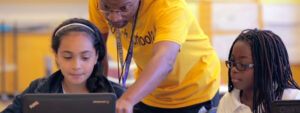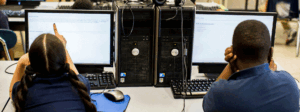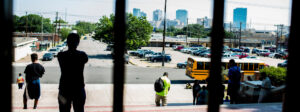Picture this scenario from a school of the future: Classrooms full of kids glued to computers or tablets, nary a teacher in sight. No human interaction, just the sounds of pings and clicks and hums. That’s the doomsday version, offered by those who have the wrong understanding of “blended learning” and incorrectly assume that it diminished the role of the teacher.
[subscribe]
But that’s not the goal of blended learning—far from it. Blended learning combines the best in-person instruction and online technology to deliver student-centered learning. In reality, blended learning can open up huge possibilities for students, giving them the chance to access a wide and rich pool of materials while still benefitting from being in a physical school—with real teachers, whose role (more than ever) is to help students build connections, understand the content they’re engaging with, and tailor instruction to meet individual students’ needs.
Without teachers, in other words, blended learning isn’t learning at all.
But teachers can’t be expected to know how to get blended learning right, right off the bat. As students do more and more of their learning on computers, teachers need guidance to make the most of the opportunities blended learning presents.
We recently partnered with the five Raise Your Hand Texas Raising Blended Learners districts, to help them make the transition to blended learning and learn more about the most effective ways to prepare teachers for working in blended environments.
So how do you support teachers to make the most of blended learning opportunities? And how can districts scale blended learning programs without leaving teachers in the dark on how to do their jobs well?
We don’t have all the answers (far from it), but our partnership with Raising Blended Learners helped us pilot a handful of strategies—and we learned a lot. Here’s what it looked like:
We started off by taking a close look at each district’s approach to instruction. Altogether, we visited 16 schools, observed 150 classrooms, and analyzed 639 student work samples. We wanted to understand what learning looked like before districts launched new blended learning initiatives.
Though our partner districts were diverse, their challenges and opportunities were similar. We found three consistent priorities that would form the groundwork for successful blended learning across all our partner districts:
Articulate a clear vision for challenging, standards-aligned blended instruction. Having a district-wide vision for rigorous teaching and learning is always a priority—and a challenge. But what does it mean in a setting where blended learning is coming into play? How can we ensure that blended practices and materials are integrated and central to a vision for teaching and learning? In collaboration with our partner districts, we developed customized trainings for teachers and leaders to grow both their understanding of rigorous content and what that can look like in a blended classroom.
For example, in one Raising Blended Learners district, we led trainings with teachers and instructional coaches focused in secondary English Language Arts classrooms. These instructional practices included: (1) ensuring students have regular practice with complex texts and its academic language, (2) ensuring students spend significant time reading, writing, and speaking grounded in evidence from the text, and (3) building student knowledge through content-rich non-fiction. By collectively defining what a rigorous secondary ELA classroom should look and sound like, teachers and school leaders were better equipped to turn that vision into reality. In fact, we led small groups of teachers to collaboratively plan how to integrate these rigorous instructional practices into their upcoming blended learning units and lesson plans.
Over the course of our partnership, we saw teachers and leaders raise their own standards for what kids should be learning. Many recognized that it was not enough to focus on how to integrate blended learning in their classrooms if the work students were doing did not meet a rigorous bar. To unlock all the possibilities blended learning classrooms offer kids, teachers need clarity on not only what level of challenge is appropriate for each student, but also on what that looks like when integrated with technology.
Give teachers regular coaching, using a rubric designed for blended learning classrooms. As important as it is to make sure everyone understands what rigorous content looks like, if teachers don’t receive the support they need to teach this content, kids aren’t able to reap the full benefits of studying that content. At TNTP, we have seen that observing teachers and giving them bite-sized, actionable, consistent feedback is critical to their professional growth, and to the success of students. However, clear, consistent, and high-quality structures for providing regular feedback to teachers was missing in several of the Raising Blended Learning districts. Even in our partner districts where there was consistent and dedicated coaching practices and protocols, the implementation of blended learning infused a whole new set of questions. What am I looking for in these classrooms? How do I assess the rigor of a lesson when students are working on different lessons? What is the role the teacher should be playing in the classroom? What does excellence look like? Even when districts had answers for these questions, they realized that this shift in roles and responsibilities also required a shift in tools to support teachers.
In our partner districts, we piloted the TNTP Blended Core Rubric. It’s a version of our regular Core Rubric, which focuses on observing student actions rather than teacher moves—but it’s designed specifically for blended learning classrooms. So, for example, the TNTP Blended Core Rubric adds an additional performance area specifically focused on student agency, and it adds additional guidance for observing and gathering evidence in blended classroom settings across performance areas.
It was exciting to see the Blended Core Rubric in action—and to see instructional leaders warm to it. Through training sessions that included teacher-coach role plays, we watched as instructional leaders developed the skills to put the rubric to use by identifying one or two pieces of clear feedback that could be easily digested by a teacher in a single feedback session. We also saw that as instructional leaders shifted their perspective in classrooms, from observing what teachers were doing to focusing on the actions of students, they were able to give more targeted and helpful feedback to help teachers grow their practice in a way that would ultimately improve learning outcomes for kids. In the words of one Raising Blended Learners district coach, “TNTP gave us a new lens for classroom observations. The Blended Core Rubric gave us a tool for looking at the effectiveness of instruction in our blended classrooms. We were able to look at what was happening at every station and measure the rigor and value of the content at those stations.”
By the time we reached the end of the school year, coaches were taking it upon themselves to encourage cultures of feedback and continuous improvement in their schools. They also realized that using student-level examples and directly sharing feedback could increase their credibility with teachers—who need and want support as they shift toward a different approach to teaching and learning.
Offer exemplars of blended learning in action. We realized quickly that to make the coaching truly effective, it would be important to offer exemplar instruction to help teachers and instructional leaders learn by watching blended learning in action. But that looked different in different places, since our district partners had such varying needs. In some districts, we integrated video into training sessions with coaches. In another, we worked in just one classroom to make sure it was strong enough to serve as a model for others across the entire district. In each partner district, though, it was crucial to find a way to offer a real blended classroom as a model as teachers and school leaders built their skills. Being able to show a vision of what is possible, especially when it is within your own local context, has profound implications for managing this change within a district.
*
[related]
Blended learning may become a crucial component of more and more of tomorrow’s classrooms—and more students could be exposed to learning opportunities that integrate technology, online learning, and in-person instruction. But to make the most of those opportunities, teachers and school leaders have to be prepared to make the shift in a way that keeps great teaching and rigorous student learning at the center. Thinking about blending learning through a lens of academic rigor and instructional improvement seemed to make a difference in the districts we worked with—and we’re convinced that getting those foundational pieces right will help build a bridge between our traditional models of instruction and new blended learning models.
To learn more about Raising Blended Learners and read FSG’s Year 1 Evaluation Report, click here.





